#HybridElectricVehicle
Explore tagged Tumblr posts
Text



Toyota Camry 2.5 V Hybrid 2025
#philippines#cabanatuan#vehicle#toyota philippines#toyota#toyotaphilippines#toyota cars#toyota camry#toyota camry hybrid#hybrid vehicle#hybrid#hybrid electric vehicle#hybridelectricvehicle#hybridvehicle#toyota motor philippines
0 notes
Text
Hyundai Creta Electric: Hindistan Pazarında Elektrikli SUV

Hyundai Creta Electric: Hindistan Pazarına Elektrikli Giriş

Hyundai, Hindistan pazarında dikkat çekici bir yenilikle karşımıza çıkıyor: Creta modelinin tamamen elektrikli versiyonu, Creta Electric. Bu model, sıfır emisyonlu bir sürüş deneyimi sunarken, şık tasarımı ve etkileyici performansıyla da öne çıkıyor. Tasarım Özellikleri Creta Electric, içten yanmalı motor (ICE) versiyonundan önemli farklılıklar ile yeniden tasarlanmış bir ön bölüm ve arka tampon ile dikkat çekiyor. Özellikle: - Bölünmüş ızgara tasarımı, pikselli bir desenle tamamen kapatılmış. - Alt tampon girişinde yer alan aktif aero kanatçıklar, aerodinamik performansı artırıyor. - Arka tamponda ise pikselli desen ve gizli plastik kaplama kullanılmış. - Yan profilde, aerodinamik olarak optimize edilmiş yeni 17 inç jantlar öne çıkıyor. Performans ve Menzil Hyundai, elektrik motorunun teknik detaylarını henüz açıklamamış olsa da, Creta Electric'in etkileyici performansı dikkat çekiyor. Araç, 0'dan 100 km/s hıza yalnızca 7.9 saniyede ulaşabiliyor ve bu hızlanma, ICE motorlu Creta N Line'dan daha hızlı. Creta Electric, iki farklı batarya seçeneği sunuyor:

- 42 kWh batarya ile 390 km menzil. - 51.4 kWh batarya ile 473 km menzil. Şarj Süresi Creta Electric, DC hızlı şarj ile sadece 58 dakikada yüzde 10'dan yüzde 80'e kadar şarj edilebiliyor. Ayrıca, 11 kW AC şarj ile 4 saatte yüzde 10'dan yüzde 100'e ulaşmak mümkün. İç Tasarım ve Özellikler Creta Electric'in iç mekanında, Hyundai'nin Ioniq 5 modelinden ilham alınarak tasarlanmış yeni bir direksiyon simidi yer alıyor. Orta konsolda, sürüş modu seçimi için pratik bir düğme bulunmakta. Araç, üç farklı sürüş modu sunuyor: - Eco - Normal - Sport Ayrıca, çift 10.25 inç ekranlı dijital kokpit ve V2L (Vehicle-to-Load) fonksiyonu, sürücülerin ihtiyaçlarını karşılamak üzere tasarlanmış. Rekabet ve Çıkış Tarihi Hyundai Creta Electric, Hindistan pazarında Suzuki eVitara, Mahindra BE 6 ve Tata Curvv EV gibi elektrikli SUV'lerle rekabet edecek. Creta Electric, 17 Ocak'ta Hindistan'daki Bharat Mobility Show'da resmi olarak tanıtılacak. Diğer pazarlarda satışa sunulup sunulmayacağı ise henüz netlik kazanmış değil. Read the full article
#atecaelektriklikoltuk#CretaElectric#cretaelectriconroadprice#cretaelectricseat#cretaelena#cretaeletrico#creta+mileage#diagramaelectricohyundaicreta#evehicleelektriklimotor#electriccreta#elektrikliaraç#elektrikliaraçvolta#gta5electriccars#hargahyundaicretaelectric#Hindistan#hondacrvelectric#hyelectriccar#hybridcarelectricmotor#hybridcarvselectriccar#hybridelectricvehicle#hybridelectricvehicleanimation#hybridelectricvehiclecourse#hybridelectricvehicleworkingprinciple#hybridmielektriklimi#hybridorelectriccar#Hyundai#hyundaiaccenteraelektriklidireksiyonkutusu#hyundaiaraçlarınvergiborcunekadardır#hyundaicreta2023#hyundaicreta2024electric
0 notes
Link
#AdvancedCleanTrucklegislation#Airstream#andcommercialEV#CaliforniaAirResourcesBoard#ElectricVehicle#EV#Futurride#gasolinerangeextender#Harbinger#HybridElectricVehicle#Jayco#recreationalvehicle#RV#sustainablemobility#THOR#THORIndustries#ThorMotorCoach#Tiffin
0 notes
Text
Internal Combustion Engine
March 5, 2024
by dorleco
with no comment
Autonomous Vehicle Technology
Edit
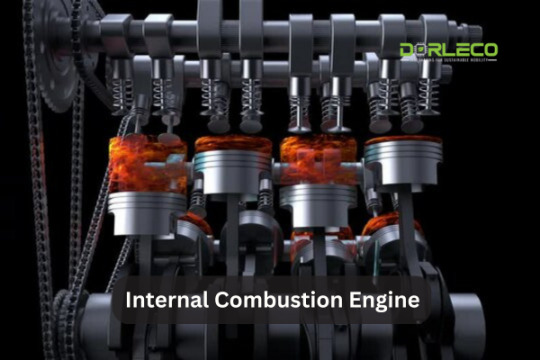
Introduction
In the United States, internal combustion engines power almost 250 million highway vehicles due to their exceptional longevity and drivability. They can run on renewable or alternative fuels in addition to gasoline or diesel (e.g., natural gas, propane, biodiesel, or ethanol). Additionally, they can be paired with plug-in hybrid electric systems to increase the range of hybrid electric vehicles or with hybrid electric powertrains to improve fuel efficiency.
Internal combustion engines are divided into two groups:
Continuous combustion:
Engines with both intermittent and continuous combustion. Fuel and oxidizer enter the engine steadily, which is the hallmark of a continuous-combustion engine. An engine (such as a jet engine) maintains a steady flame.
Intermittent-combustion engines:
The air and fuel in an intermittent combustion engine ignite periodically, giving rise to the term “reciprocating engine.” A cycle is used to process discrete amounts of fuel and air. Examples of this second type are diesel engines and gasoline piston engines.
A sequence of thermodynamic events can be used to describe internal combustion engines. Thermodynamic processes take place concurrently in a continuous-combustion engine as the fuel, oxidizer, and combustion products move through the engine in a steady flow.
In contrast, all of the events in an intermittent combustion engine happen one after the other and are repeated throughout each cycle.
Internal combustion engines consume air, compress it, and either introduce fuel into the air or compress the air-fuel combination. Rockets are an exception to this rule, as they use both liquid-propellant and solid rocket motors.
The air-fuel mixture is then burned, work is obtained from the expansion of the hot gaseous combustion products, and finally, the combustion products are discharged through the exhaust system, as is the case with all internal combustion engines.
Their functioning can be compared to that of external combustion engines (such as steam engines), where energy is obtained exclusively by heat transfer to the working fluid via a heat exchanger and no chemical reaction occurs in the working fluid.
The four-stroke, gasoline-powered, homogeneous-charge, spark-ignition engine is the most widely used internal combustion engine. This might be attributed to its exceptional performance as a leading player in the ground transportation sector.

The aeronautics industry uses spark-ignition engines as well, but because of its focus on range, speed, and passenger comfort, aircraft gas turbines have emerged as the industry’s main players.
Exotic systems including advanced rocket engines and motors, like those found on U.S. space shuttles and other spacecraft, and supersonic combustion ramjet engines (scramjets), like those envisioned for hypersonic aircraft, are also included in the category of internal combustion engines.
How Does An Internal Combustion Engine Work?
The fundamental chemical process of releasing energy from a fuel and air mixture is called combustion, or burning. The process of fuel ignition and combustion in an internal combustion engine (ICE) takes place inside the engine. After that, the engine uses a portion of the energy produced by combustion to power itself. A stationary cylinder and a moving piston make up the engine. The crankshaft rotates as a result of the piston being pushed by the expanding combustion gasses. In the end, this action turns the wheels of the car through a set of gears in the powertrain.
The spark-ignition gasoline engine and the compression-ignition diesel engine are the two types of internal combustion engines that are currently in production. The majority of these are four-stroke engines, which require four piston strokes to complete a cycle. The intake, compression, combustion, power stroke, and exhaust are the four independent operations that make up the cycle.
The methods used by compression ignition diesel engines and spark ignition gasoline engines to feed and ignite fuel are different. During the intake phase in a spark ignition engine, fuel and air are combined and then forced into the cylinder. The fuel-air mixture is compressed by the piston and then ignited by the spark, leading to combustion. During the power stroke, the piston is pushed by the combustion gasses’ expansion. Only air is introduced and subsequently compressed into an engine in a diesel. The fuel then ignites when diesel engines spray it into the hot compressed air at a proper, controlled rate.
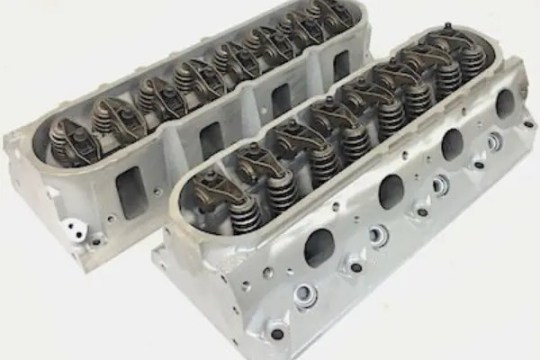
In essence, an internal combustion engine converts the air-fuel mixture’s heat energy into mechanical energy. The reason it is named Four Strokes is that a full combustion cycle in the piston requires four strokes to complete. An internal combustion engine, sometimes known as an ICE (internal combustion engine), is a four-stroke piston engine that powers a passenger car.
Let’s now investigate which constitutes an ICE’s principal parts.
The camshaft(s), valves, valve buckets, valve return springs, spark/glow plugs, and injectors (for direct injection engines) are typically located in the cylinder head. The engine’s cooling liquid passes via the cylinder head.
We can locate the piston, connecting rod, and crankshaft inside the engine block. Regarding the cylinder head, coolant passes through the engine block to assist in regulating the engine’s temperature.
From BDC to TDC, the piston travels inside the cylinder. When the piston is near TDC, a volume is formed between the cylinder head, engine block, and piston. This space is known as the combustion chamber.
An ICE with four strokes has the following phases (strokes) in a complete engine cycle:
Intake power (expansion) exhaust compression intake The piston’s movement between the bottom and top dead centers is referred to as a stroke.
Now that we are aware of an ICE’s constituent parts, we can investigate the actions that take place throughout each engine cycle stroke. The position of the piston at the start of each stroke and the specifics of what happens inside the cylinder are displayed in the table below.
Stroke 1 – INTAKE
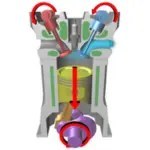
Stroke 2 – COMPRESSION
After the intake stroke is complete, the piston begins the compression stroke at BDC. The intake and exhaust valves close during the compression stroke, and the piston travels toward TDC. The air/mixture is compressed when both valves are closed, and when the piston approaches TDC, the pressure reaches its maximum. During the compression stroke, just before the piston reaches TDC (but not quite there),
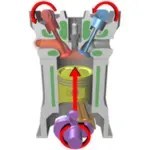
Stroke 3 – POWER

Stroke 4 – EXHAUST
After the power stroke is over, the exhaust stroke begins with the piston at the BDC. There is an open exhaust valve during this stroke. Most of the exhaust gasses are forced out of the cylinder and into the exhaust pipes by the piston’s movement from the BDC to the TDC. The engine uses energy during the exhaust stroke because the components’ inertia causes the crankshaft to rotate.
As you can see, the piston needs to make four strokes to complete a combustion (engine) cycle. This indicates that two full crankshaft revolutions (720°) are required for one engine cycle.

Advantages of internal combustion engines
Engine size is extremely small in comparison to external combustion engines.
The power-to-weight ratio is elevated.
Excellent for applications with low power requirements
Typically, more transportable than external combustion engines of the same kind
safer to use with a much shorter start time
Higher efficiency compared to an external combustion engine
There is no possibility of working fluid leaks minimal upkeep is necessary
Compared to external combustion engines, there is a reduction in lubricant use.
Because the peak temperature is only achieved briefly (during the fuel’s explosion), the overall working temperature in the case of reciprocating internal combustion is modest.
Disadvantages of internal combustion engines
The range of fuels available for utilization is restricted to extremely high-quality gaseous and liquid fuels.
Fuel utilized, such as gasoline or diesel, is quite expensive.
In general, engine emissions are higher than those of an external combustion engine.
Unsuitable for producing significant amounts of power When there is reciprocating internal combustion, fuel detonation produces noise.
Types and applications of internal combustion engine:
Gasoline engines are utilized in automobiles, boats, and airplanes.
Gas engines are employed to provide industrial power.
Diesel engines are utilized in the automotive, railroad, power, and marine industries.
Gas turbines: They are employed in the maritime, industrial, and aircraft industries.
Conclusion:
To sum up, for more than a century, internal combustion engines have been essential in powering a variety of industry and transportation options. They are essential to contemporary industrialization and mobility because of their effectiveness, dependability, and flexibility. However, the desire to switch to greener, more sustainable options is growing as worries about the effects on the environment and the depletion of resources increase.
Internal combustion engines’ dependence on fossil fuels is still a severe disadvantage, despite notable improvements in efficiency and emissions reduction. Research and development efforts are being directed toward alternative fuels like biofuels and hydrogen, as well as electrification technologies like electric and hybrid powertrains, in an attempt to address these problems.
Moreover, the use of sophisticated engine management systems, lightweight materials, and enhanced aerodynamics keeps improving internal combustion engine performance and fuel efficiency. To combat climate change and lessen reliance on limited resources, a thorough transition to greener transportation options is required.
In conclusion, even though internal combustion engines have proved essential to contemporary transportation and industry, there are growing concerns about their long-term viability. The key to the future is adopting cutting-edge technologies that balance environmental protection with the changing demands of society for dependable and efficient power sources.
Also Read: Things to know about Hybrid Powertrains
#InternalCombustionEngine#VCU#Powertrains#EVEMS#EVCharging#Dorleco#ADAS#Electricmotor#EVs#Hybridelectricvehicles#Electrigenerator
0 notes
Text
What is the power behind HEVs?
The power behind HEVs #HEV #hybridElectricVehicle #electricvehicle #EVs #automotive #batterychargingstation
Why HEVs are in demand? What is the power behind HEVs? Hybrid electric vehicles (HEVs), which combine the advantages of internal combustion engines (ICEs) and electric motors, represent a significant advancement in automotive technology. Fuel efficiency is improved with reduced emissions and enhanced driving performance. The major components of Hybrid Electric Vehicles Internal combustion…
0 notes
Text




Electrical Vehicles share of Vehicle Sales by Mode and Scenario in India, China, Europe and Rest of the world, 2030
Read More
#electricvehicles#renewableenergy#electricvehiclesindia#vehiclesales#businessdata#globalisationsimplified#hybridelectricvehicle#twowheelerelectricvehicles#threewheelerelectricauto#lightdutyvehicles#electricbus#electrictruck
2 notes
·
View notes
Photo

The new @landrover Range Rover Evoque 2020 is a sustainable hybrid car with an interior featuring durable materials like leather — tap the link in bio to read + about this emission-free ride with a unique design 🌱 ⠀ #landrover #rangerover #evoque #phev #hybridelectricvehicle #hybridsuv #luxurysuv #4x4 #carsofinstagram #technology #suv #electric #vehicle #carphoto #dreamcar #car #carfreak #nicecar #photogrsphy #hypecar #luxury #supercarage https://www.instagram.com/p/CA1_Adrgy_R/?igshid=8847w13pcak6
#landrover#rangerover#evoque#phev#hybridelectricvehicle#hybridsuv#luxurysuv#4x4#carsofinstagram#technology#suv#electric#vehicle#carphoto#dreamcar#car#carfreak#nicecar#photogrsphy#hypecar#luxury#supercarage
0 notes
Photo

The vision of NASA’s Urban Air Mobility Challenge is to develop an integrated next generation urban aviation grid. With the advent of electric aircrafts with dramatically reduced or even set emissions, it becomes possible to utilize airspace for transport of materials and personnel across short distances in cities. Prioritizing safety and low noise, large metropolitan areas may soon convert to smart cities with state-of-the-art transportation. . As with the implementation of any new technologies, especially one that can affect many industries, many challenges lie ahead. Thus, research is focused on acquiring data, determining regulations, and operational rules. . What do you think about NASA’s initiative? Would you be interested in helping develop this? Leave comments and or thoughts about how this or a similar technology could help the area that you live in. . Credit: NASA / Advanced Concepts Laboratory / Lillian Gipson / public domain, NUAIR Alliance / Eric Millier. . #nasa🚀 #smartcity #hitech #technology #aviation #drones #urbandevelopment #hybridelectricvehicle #newconcept #futuristic #futurism https://www.instagram.com/p/BynkiDmBK3X/?igshid=lnysjm66iyo3
#nasa🚀#smartcity#hitech#technology#aviation#drones#urbandevelopment#hybridelectricvehicle#newconcept#futuristic#futurism
0 notes
Photo

“Black Ocean” Limited Edition Karma Revero (I’m in middle of the team just above the roof 😉) #karmarevero #karmaautomotive #automobile #hybridelectricvehicle #luxurylifestyle (at Moreno Valley, California) https://www.instagram.com/p/BxC9-S1AZsq/?utm_source=ig_tumblr_share&igshid=14ltgw3gx9kok
0 notes
Link
Testing of Electric and Plug-in Hybrid Electric vehicles has new challenges with respect to the ever-increasing demands of the EV market, the test cases, and the testing procedures. Main questions arise from the fact that automotive companies have to balance testing coverage and risk with cost and time without compromising on the quality and effectiveness.
0 notes
Link
#AstonMartin#CarbonFiber#F1#FormulaOne#Futurride#GoodwoodFestivalofSpeed#HEV#HybridElectricVehicle#hybridhypercar#lightweighting#Michelin#OracleRedBullRacing#PlayStationX1#RB17#RedBull#RedBullAdvancedTechnologies#RedBullRacing#RedBullRB17#Sony#sustainablemobility#Valkyrie
0 notes
Text
EV Energy Management Systems (EVEMS)
March 1, 2024
by dorleco
with no comment
Control Systems

Introduction
Sales of electric automobiles are rising. By the end of 2021, there will be over 16.5 million electric vehicles on the road worldwide, which is quadruple the number from 2018.
EVs also bring with them an increasing electricity demand. According to the 2020 International Energy Agency’s Global EV Outlook, during periods of peak demand, the percentage of electricity used for EV charging might reach as high as 4–10% by 2030.
However, the majority of cars—EVs included—are parked for approximately 95% of the time. In addition, there are times during the day when the peak demand for power varies dramatically, resulting in periods of unused production capacity.
Managing electrical capacity when maintaining charging stations has become more difficult as electric vehicles have grown in popularity in Canada, particularly in multi-use residential and commercial buildings.
Although a lot of companies are installing EV charging stations to accommodate their clients, employees, and tenants, there’s a chance that the whole load will surpass the energy capacity. EV energy management systems (EVEMS) can help with it.
Challenges to the widespread adoption of EVs
1. Inadequate infrastructure for charging
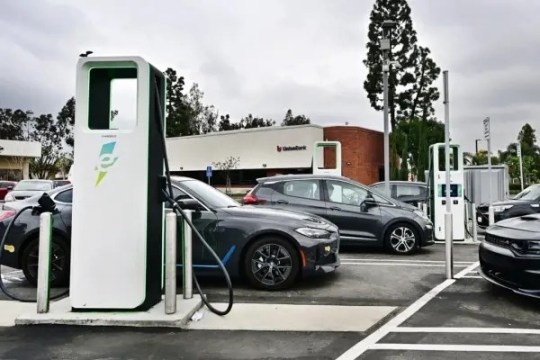
The broad adoption of electric vehicles is severely hampered by the inadequate infrastructure for charging them. This is especially true in less developed or rural locations, where there are fewer charging stations, deterring drivers from switching to electric cars.
Range anxiety is also brought on by a lack of charging infrastructure, since drivers may worry that they won’t be able to locate a charging station when traveling long distances.
2. Overloaded electrical grids
The possibility of grid overloading is another obstacle to the widespread use of electric vehicles. The demand for power rises as more and more electric vehicles are connected to the grid, increasing the risk of grid overloading at times of peak demand.
This can therefore lead to problems such as blackouts and other problems that could harm the electricity system’s dependability.
3. Insufficient availability of vital minerals
The insufficient availability of vital minerals and rare earth metals required for electric vehicle infrastructure is a significant obstacle to the extensive integration of electric vehicles.
These minerals are needed to produce EV batteries and other necessary parts. However as the number of EVs on the road rises, demand for certain minerals is rising quickly, and the supply of these minerals is restricted globally.
This might cause problems for EV producers in the supply chain and increase their costs, which would hinder the uptake of electric vehicles.
How smart Energy Management System can help overcome these challenges?
This is how smart EV energy management systems can help one overcome the above challenges.
1. Utilize charging infrastructure effectively
By making efficient use of the current infrastructure, smart energy management systems might potentially address the issue of insufficient charging infrastructure.
These systems can maximize charging station utilization while minimizing their impact on the power grid by analyzing energy consumption, renewable energy generation, and energy costs.

This can facilitate the mass adoption of electric vehicles by reducing the need for costly infrastructure upgrades and improving the accessibility and dependability of the charging infrastructure.
To further improve the effectiveness of the charging infrastructure, electric vehicle drivers can also receive real-time information about the location and availability of charging stations by using mobile apps and EV energy management software.
2. Load balancing to prevent excessive load on the grid
Potentially, smart energy management technologies can help with grid overload issues. By coordinating the charging of loads to occur during off-peak hours, when there is less power demand, these sophisticated systems can distribute the load on the grid.
Smart energy management systems can increase grid stability and dependability by employing this technique to keep the grid from suffering extra demand during peak times.
Moreover, by utilizing energy produced during off-peak hours, when renewable sources like solar and wind power are more plentiful, this technique can maximize the usage of renewable energy sources.
Battery monitoring and recycling to reduce the carbon footprint of EVs To reduce the carbon footprint of electric vehicles (EVs), battery recycling and surveillance are essential.
By gathering vital information on battery health and consumption statistics, intelligent energy management systems may dramatically maximize the efficiency of electric vehicle batteries.
Moreover, intelligent energy management systems can guarantee that batteries are properly recycled at the end of their useful lives, reducing the environmental impact of electric vehicles.
This entails decreasing the need for mining, recovering vital components and rare earth metals required in battery production, and lowering the carbon footprint associated with battery production.
3. For EVs, why should you choose a smart Energy Management System app?
An intelligent energy management app for electric vehicles (EVs) maximizes energy use, which lowers costs and boosts sustainability and efficiency.
It enables EV owners to control several energy-related aspects of their cars, such as battery consumption and charging duration.
4. Detailed user analytics
One of the main advantages of the smart EV app for energy management is the availability of thorough data. Analyzing and tracking a user’s energy consumption patterns can be made easier with the help of a smart EV energy management system.
In turn, this can help owners of electric vehicles (EVs) identify inefficient locations and make data-driven choices to maximize their energy use.
EV owners can obtain a thorough insight into their energy consumption, charging history, and driving trends by applying extensive user statistics, like those offered by the Tesla application.
Furthermore, tailored suggestions can be provided to enhance energy efficiency, such as cutting back on energy use during peak hours and timing charging to prevent needless energy loss.
By putting these suggestions into practice, the EV’s range may be increased and driving enjoyment may be enhanced overall.

5. Cost savings
An intelligent EV energy management system can help owners of electric vehicles (EVs) reduce their charging costs and hence improve their overall cost-effectiveness by maximizing energy use.
As an example, a powerful EV smart energy management system may identify charging infrastructure inefficiencies and continuously monitor charging operations in real time.
This information can help EV owners minimize energy loss and associated costs by helping them make informed decisions about when and how to charge their cars.
6. Improved experience for users
EVs offer several advantages for energy management, including better user experience. Developing a strong EV energy management system can greatly improve the experience for the final user.
First off, owners of electric vehicles can monitor and control their charging sessions with ease thanks to the user-friendly interface provided by EV energy management software, which increases convenience and flexibility.
For example, the EV energy management software can provide customized charging schedules according to the user’s driving habits and preferences, making charging smooth and enjoyable.
EV owners may also make informed decisions about their energy usage and its ecological impact by using the EV energy management system, which can offer them insights into their energy consumption and carbon footprint.
7. Enhances synchronization
A robust energy management platform designed for electric vehicles (EVs) can improve communication between power grids, EV drivers, and the charging infrastructure.
With the help of the EV smart energy management application, drivers of electric vehicles may plan the most efficient routes and steer clear of needless detours by accessing real-time information about the availability and status of charging stations.
Additionally, by enabling two-way communication between EV drivers and power grids, the EV energy management program can improve the synchronization of energy supply and demand.
The program ensures that electricity demands stay balanced and maintains grid stability by adjusting the billing rate based on the available capacity of the grid.
Additionally, by encouraging EV drivers to charge their cars during off-peak hours, the EV energy management platform can help reduce peak demand, ease grid stress, and lessen the chance of blackouts.
8. Reduction in consumption of essential elements
An intelligent energy management app for electric vehicle owners can optimize their energy usage and offer tools to prolong the life of the battery and check its condition.
The energy management software for EVs monitors temperature, charging habits, and battery usage to help identify potential problems and make recommendations for enhancing battery performance.
As a result, the software can aid in lowering the need for new EV batteries as well as the amount of rare earth materials needed to produce them.
The EV energy management system can also offer information on battery recycling and disposal, which is essential for minimizing environmental effects.
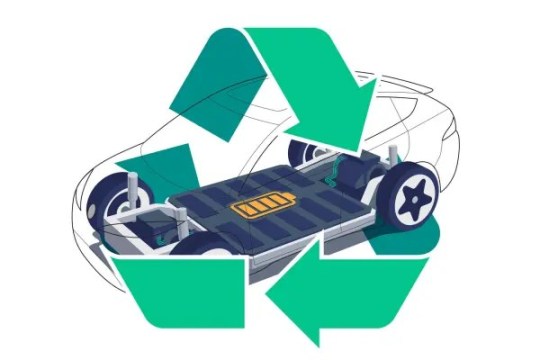
Factors to consider while implementing an effective smart Energy Management System
Have an awareness of the current state
Integration and interoperability
Choosing the right hardware and software
Scalability
Managing cyber risk
Conclusion:
The importance, difficulties, and potential applications of electric vehicle (EV) energy management systems (EMS) would be summarized as follows:
An important step forward in the integration of electric vehicles into our transportation infrastructure is the use of electric vehicle energy management systems.

These technologies are essential for maximizing energy efficiency, enhancing car performance, and guaranteeing effective charging procedures.
Electricity flow between the grid, EVs, and charging stations is intelligently managed by EMS, which improves user experience while simultaneously supporting the sustainability and stability of the power system.
The requirement for standardization and interoperability among the many parts and stakeholders in the EV ecosystem is one of the main issues facing EV EMS.
For EMS to be widely used and effective, it must be possible for various charging networks, car manufacturers, and energy providers to communicate and work together seamlessly.
Furthermore, EMS has both opportunities and challenges as a result of the quick development of EV technology and the breakthroughs made in renewable energy sources.
Adding projections for renewable energy supply, dynamic pricing models and changes in grid demand to EMS algorithms can improve their flexibility and effectiveness.
Looking ahead, to overcome these obstacles and realize the full potential of EV Energy Management Systems, more research and development work will be required.
Innovation, standardization, and scalability of EMS solutions will be driven by collaboration between industry actors, governments, and researchers.
In the end, the broad implementation of EMS promises to maximize the advantages of electric mobility while lowering greenhouse gas emissions and reliance on fossil fuels, creating a more robust and sustainable transportation system.
#EMS#VCU#Powertrains#EVEMS#EVCharging#Dorleco#ADAS#Electricmotor#EVs#Hybridelectricvehicles#Electrigenerator
0 notes
Text
Which is Right for You: HEV or PHEV?
Which is Right for You: HEV or PHEV? #HEV #PHEV #HybridElectricVehicle #ElectricVehicle #PHEV #chargingstations #sustainability
HEV or PHEV? The evolutionary nature of the automotive industry is dynamic, but how about sustainable and efficient? Are they sustainable enough for consumers to be faced with an increasing array of choices when electrified vehicles are in the picture? Till the time we start and end our debate, we have a new industry of electric vehicles in the automotive sector, and they are just about one…
0 notes
Photo

XPENG Motors Puts 30 Supercharger Stations Into Operation on the Same Day⚡️⚡️ . ===================================== 📌You can find all-electric cars news all in one link! Check the profile ⚡ ===================================== ⬆️More information in profile link🚗⬆️ . ===================================== ⬇️Turkish below⬇️ ===================================== . XPENG Motors, Aynı Günde 30 Süper Şarj İstasyonunu Kullanıcılara Sundu. Ayrıntılı bilgi bio linkte⬆️⬆️ . #toyota #carsofinstagram #instacar #greenworld #vw #nissan #tesla #zeroemission #hybridelectricvehicle #electricvehicle #greenenergy #electricvehicles #pluginhybrid #bmw #mercedes #cars #xpeng ===================================== ➡️ https://www.ngevehicles.com ===================================== https://www.instagram.com/p/BvhW76qni2Y/?utm_source=ig_tumblr_share&igshid=1dst1f80se6ve
#toyota#carsofinstagram#instacar#greenworld#vw#nissan#tesla#zeroemission#hybridelectricvehicle#electricvehicle#greenenergy#electricvehicles#pluginhybrid#bmw#mercedes#cars#xpeng
0 notes
Link
Why Should you Buy an Electric Vehicle in India?
#electricvehicle #electricvehicles #electricalvehicle #vehicleelectric #electricpoweredvehicle #electricutilityvehicle #electricvehiclecharging #electricvehiclesarethefuture #electricvehiclechargingstation #hybridelectricvehicle #electricvehiclesindia #batteryelectricvehicle #electricvehiclesonly #electricvehicletechnology #electricvehicleindia #electricvehiclecharger #electricutilityvehicles #electricalvehicles #electricvehicleshow #pluginhybridelectricvehicle #electricandhybridvehicles #tarangelectricvehicle #vehicleselectrics #electricvehiclesbali #electricvehicleparking #electricvehiclesinindia #electricvehiclesrock #electricvehiclebattery #electricvehiclesclub #electricvehiclesnews #electricvehicleshowcase #electricvehiclestechnology
1 note
·
View note
Photo

Jeep to launch Wrangler with a hybrid variant in this December The new Wrangler 4xe is noted as one of the famous off-roading SUVs in the world. http://www.headlineenglish.com/technology-news/jeep-to-launch-wrangler-with-a-hybrid-variant-in-this-december/?feed_id=10041&_unique_id=5f51b6fe24d0e #globallaunch #hybridelectricvehicle #jeepwrangler #wrangle4xe
0 notes